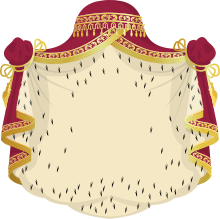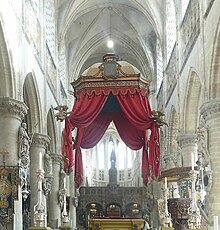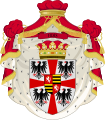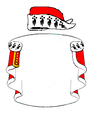Mantle and pavilion (heraldry)


In heraldry, a mantle is a symbol of sovereign power and is generally reserved for royalty. In some cases, its use has also been granted to other nobles, in recognition of particular merits. In ordinary rendering, the mantle is usually crimson and lined with ermine.
Certain coats of arms may also display a pavilion (similar to a baldachin) surmounting the mantle. The pavilion is said to be the invention of the Frenchman Philip Moreau.[1] Some republics have displayed a mantle and pavillon in their coats of arms, contemporarily Serbia.
While common in continental European heraldry, the mantle and pavilion is absent in English and Scottish heraldry.[2]
Mantle and pavilion should not be mixed with Mantling.
Gallery
Mantles
Royal mantles
- Greater arms of Sweden, featuring a purple mantle but with no pavilion
- King Carl XVI Gustaf of Sweden's former arms as crown prince, with a blue mantle reflecting the Swedish princely mantle
- Royal Arms of the Kingdom of Denmark
Non-royal mantles
- Coat of arms of the House of Montmorency, from the era of the Bourbon Restoration, with a blue mantle and ducal coronet
- Coat of arms of the Prince of Lichenstein, with a purple princely mantle
- Coat of arms of the House of Gonzaga
- Coat of arms of the Princes Sułkowski, a Polish princely family
- Historical mantle and chapeau of a Scottish feudal baron
- Mantle and coronet of a Grandee of Spain
- Mantle and princely hat of a Russian prince
Mantles of chivalric orders
- Arms of Maximilian von Fürstenberg with the mantle of the Order of the Holy Sepulchre
- Arms of the Sovereign Military Order of Malta
- Arms of the Order of Saint Lazarus
Mantles with pavilions
- Grand coat of arms of the Kingdom of France
- Greater coat of arms of the Russian Empire
- Coat of arms of the Dutch monarch, with a mantle and pavilion
- Coat of arms of the Karadjordjevic dynasty
See also
References
- ^ Fox-Davies, Arthur Charles (1909). A Complete Guide to Heraldry. London & Edinburgh: T.C. & E.C. Jack. p. 401.
- ^ Fox-Davies, Arthur Charles (1909). A Complete Guide to Heraldry. London & Edinburgh: T.C. & E.C. Jack. p. 400.


















